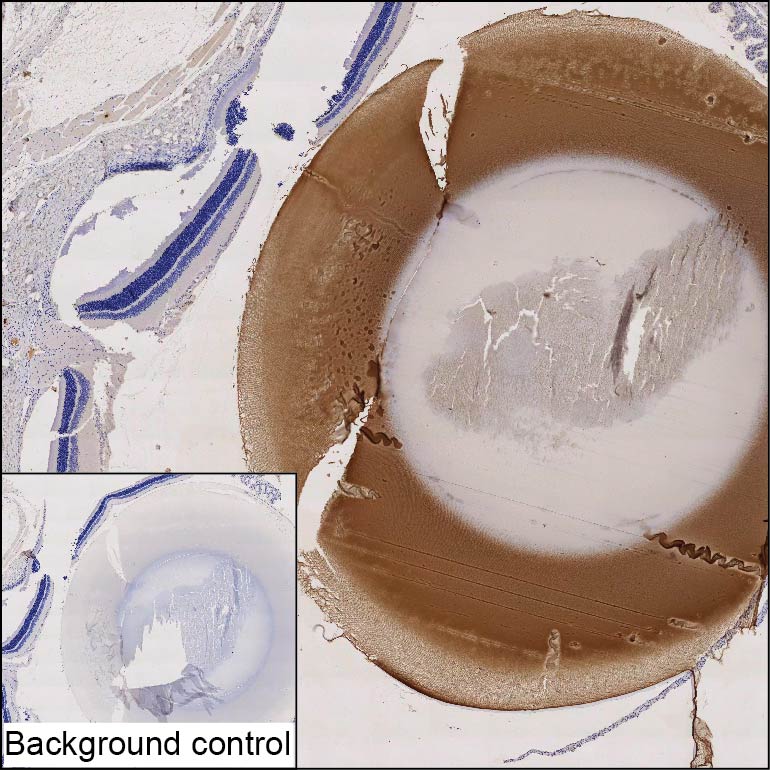
| WB | 咨询技术 | Human,Mouse,Rat |
| IF | 咨询技术 | Human,Mouse,Rat |
| IHC | 1/20-1/100 | Human,Mouse,Rat |
| ICC | 技术咨询 | Human,Mouse,Rat |
| FCM | 咨询技术 | Human,Mouse,Rat |
| Elisa | 咨询技术 | Human,Mouse,Rat |
| Host/Isotype | Mouse IgG2a |
| Antibody Type | Primary antibody |
| Storage | Store at 4°C short term. Aliquot and store at -20°C long term. Avoid freeze/thaw cycles. |
| Species Reactivity | Human |
| Immunogen | Purified recombinant fragment of human CRYAA |
| Formulation | Purified antibody in PBS with 0.05% sodium azide |
+ +
以下是关于CRYAA(αA-晶状体蛋白)抗体的3篇代表性文献摘要概览:
---
1. **文献名称**:*AlphaA-crystallin as a molecular chaperone*
**作者**:Horwitz J (1992)
**摘要**:该研究首次提出CRYAA(αA-晶状体蛋白)具有分子伴侣功能,通过抑制热应激或氧化损伤下晶状体蛋白的异常聚集来维持晶状体透明度。实验中利用CRYAA抗体验证其在体外模型中的保护作用,为白内障机制研究奠定基础。
2. **文献名称**:*Expression of alphaA-crystallin in the developing mouse lens*
**作者**:Bhat SP et al. (1991)
**摘要**:通过免疫组织化学结合CRYAA抗体,研究揭示了αA-晶状体蛋白在小鼠晶状体发育中的时空表达模式,证实其在胚胎期晶状体上皮细胞分化和纤维细胞成熟中的关键作用。
3. **文献名称**:*CRYAA mutations alter its chaperone activity and increase cataract risk*
**作者**:Andley UP et al. (2000)
**摘要**:利用CRYAA特异性抗体进行Western blot和免疫荧光分析,发现某些突变型CRYAA蛋白因分子伴侣功能丧失而更易聚集,直接关联于遗传性白内障的发生。
---
以上文献涵盖了CRYAA的功能验证、发育表达及疾病机制研究,均通过特异性抗体技术揭示其生物学特性。如需扩展,可进一步检索近年研究(如氧化应激模型中CRYAA的抗体应用)。
**Background of CRYAA Antibody**
CRYAA (αA-crystallin) is a small heat shock protein (sHSP) belonging to the crystallin family, primarily expressed in the eye lens and certain muscle tissues. It plays a critical role in maintaining lens transparency and cellular proteostasis by acting as a molecular chaperone, preventing the aggregation of misfolded proteins under stress conditions. CRYAA forms hetero-oligomers with its homolog, αB-crystallin (CRYAB), enhancing its stability and functional versatility.
Mutations in the *CRYAA* gene are linked to congenital cataracts and other ocular pathologies, while its dysregulation has been implicated in neurodegenerative diseases and cancers. CRYAA antibodies are essential tools for studying its expression, localization, and interactions in both physiological and disease contexts. These antibodies are widely used in techniques like Western blotting, immunohistochemistry (IHC), immunofluorescence (IF), and ELISA to investigate CRYAA's role in lens development, stress response, and disease mechanisms.
Research utilizing CRYAA antibodies has advanced understanding of its dual roles in structural lens integrity and cytoprotection, highlighting its potential as a therapeutic target for cataracts and protein-aggregation-related disorders.
×